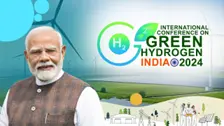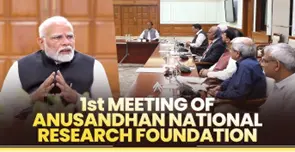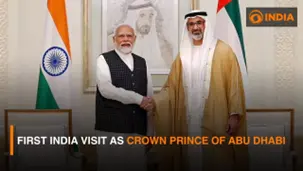Saturday, 14th September 2024
The Great Stupa of Sanchi
Why in the news?
- Recent visit to Germany, the External Affairs MinisterShri. Jayshankar of India paid a visit to the replica of Sanchi's Great Stupa's EastGate standing in front of Humboldt Forum Museum in Berlin.

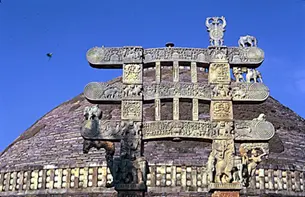
Img: Sanchi Stupa Img: East Gate
What is a Stupa?
- Meaning:
- A stupa in Buddhism is a dome-shaped structure that contains relics, typically those of Buddha or revered monks, and serves as a place of meditation.
- Origin:
- Stupas were originally pre-Buddhist burial mounds in ancient India, which later gained religious significance in Buddhism.
- Development:
- Expansion under Ashoka (250 BCE): Emperor Ashoka, a patron of Buddhism, is said to have built 84,000 stupas to distribute Buddha’s relics across India.
- Decorated Stupas (125 BCE): By the 2nd century BCE, stupas like those in Bharhut, Bodh Gaya, and Sanchi began to be adorned with sculptural reliefs.
- Gandhara Development (3rd century BCE - 5th century CE): In Gandhara, the stupa design evolved significantly, influencing Buddhist architecture in Central Asia, China, Korea, and Japan.
- The Great Stupa of Sanchi
- About:
- Built in the 3rd century BCE by Ashoka, the Great Stupa of Sanchi is India’s oldest stone structure.
- It contains the relics of Buddha and his disciples Sariputra and Maudgalyayan.
- Rediscovered in 1818 by British General Henry Taylor, it was restored in the early 20th century by John Marshall with funding from Bhopal’s begums.
- Declared a UNESCO World Heritage Site in 1989, it is located in Sanchi Town, Madhya Pradesh.
- Significance:
- The Stupa is a key site for understanding the evolution of Buddhist art and architecture in India.
- About:
- The Gateways (Toranas) of the Great Stupa
- About:
- The original stupa was plain, but the four ornate gateways were added in the 1st century BCE during the Satavahana reign.
- These toranas face the four cardinal directions and depict scenes from Buddha’s life and the Jataka tales through exquisite sculptures.
- East Gate of Sanchi Stupa:
- Upper architrave: Depicts the seven Manushi Buddhas.
- Middle architrave: Shows the Great Departure of Siddhartha.
- Lower architrave: Illustrates Ashoka visiting the Bodhi tree.
- Cultural Significance in Europe: The East Gate's replica, made in the 1860s by Lieutenant Henry Hardy Cole for the Victoria and Albert Museum, has been displayed in several European museums, contributing to its fame in the West.
- About:
Source: IE
Restatement of Values of Judicial Life
Why in the news ?
- The Restatement of Values of Judicial Life is a code of judicial ethics adopted by the Supreme Court of India in 1997 and It outlines the ethical conduct expected from judges to preserve the integrity, impartiality, and independence of the judiciary.

Key Guidelines (16 Points of the Code):
- Impartiality and Public Confidence: Judges must avoid any actions that could erode public confidence in the impartiality of the judiciary. Justice must be seen to be done.
- Credibility and Perception: Any official or personal act by a judge that might undermine the public’s trust in the judiciary’s credibility should be avoided.
- Non-Involvement in Elections: Judges should not contest elections to any office of clubs, societies, or associations, except those related to law.
- Professional Boundaries with Lawyers: Close personal associations with members of the Bar, especially those practicing in the same court, must be avoided.
- Family in Legal Practice: Judges must not allow immediate family members who are part of the Bar to appear before them or be involved in cases they handle.
- Residence for Professional Work: Judges' residences or facilities must not be used by family members for professional purposes.
- Dignified Aloofness: Judges should maintain a level of distance and dignity appropriate to their office.
- Disqualification in Certain Cases: Judges should not hear cases involving close family, friends, or companies in which they hold shares unless full disclosure is made, and no objections are raised.
- Non-Participation in Public Debates: Judges should refrain from public debates or expressing political views, especially on matters likely to come before the court.
- Media Interaction: Judges should allow their judgments to speak for themselves and avoid media interviews.
- No Gifts or Hospitality: Judges should not accept gifts or hospitality, except from family and close friends.
- Disclosure of Interests: If a judge holds shares in a company involved in a case, they must disclose this interest before hearing the case.
- Restrictions on Stock Market Activity: Judges should not speculate in shares or stocks.
- Non-Engagement in Trade or Business: Judges must not engage in trade or business, except for publishing legal work or hobbies.
- Fundraising: Judges should not solicit or engage in fundraising activities.
- Avoidance of Perquisites: Judges should not seek financial benefits or privileges beyond what is clearly available through their office.
Major Concerns About Judicial Integrity in India:
- Political Ambitions of Judges: Judges entering politics soon after resignation or retirement and accepting government roles post-retirement, especially after rulings benefiting the ruling party, suggests potential quid pro quo arrangements.
- Transparency Issues: Lack of transparency in handling sensitive cases erodes public trust in the judiciary. Opaque processes in case allocation and decision-making undermine confidence in judicial fairness.
- Conflict of Interest: Judges must avoid conflicts of interest. Involvement in political activities or delivering rulings with political impacts while still serving raises doubts about impartiality.
- Public Trust and Confidence: Actions or rulings by judges that suggest bias weaken public trust. The judiciary's legitimacy depends on maintaining a perception of integrity and fairness.
Way Forward:
- Strengthen Judicial Ethics Training: Reinforce adherence to the Restatement of Values of Judicial Life and the Bangalore Principles of Judicial Conduct through mandatory ethics training and refresher courses for judges.
- Establish Independent Oversight: Create independent bodies to audit and review judicial conduct periodically, ensuring that ethical standards are maintained.
- Leverage Global Networks: Engage with the Global Judicial Integrity Network, which assists in strengthening judicial integrity and preventing corruption, aligned with the United Nations Convention against Corruption.
- Public Engagement Initiatives: Foster public engagement by organizing forums or discussions where citizens can interact with the judiciary, enhancing transparency and trust in judicial processes.
- Cooling-off Period for Judges Entering Politics: Introduce strict cooling-off periods for judges entering politics and mandate disclosure of any judicial decisions that could raise conflicts of interest.
- Post-Retirement Roles: Establish clear guidelines for post-retirement roles, ensuring that these positions do not compromise the integrity of judicial decisions or give the appearance of political favoritism.
Commission for Scientific and Technical Terminology (CSTT)
Why in the news ?
- Recently, The Government of India under NEP 2020 is promoting education in the Indian language especially in technical fields like engineering, medicine.
- A special programme, the "AICTE Technical Book Writing and Translation" project, provides textbooks in 12 planned Indian languages.
Council on Scientific and Technical Terminology (CSTT):
- About:
- It was established in 1961 to standardize scientific and technical terminology in the Indian language.
- It also publishes dictionaries, glossaries, and bilingual, trilingual, and multilingual monographs.
- It publishes quarterly magazines like Vigyan Garima Sindhu and Gyan Garima Sindhu.
- It cooperates with textbook courses and textbook boards for university textbooks.
- Creates terminology used by government departments, research agencies and state agencies.
- ‘Shabd’ Glossary Platform:
- CSTT’s online platform Shabd (https://shabd.education.gov.in) acts as a repository of technical and scientific terms in the Indian language.
- Includes dictionaries compiled by CSTT and external organizations, allowing users to search by language, topic, or genre.
- Launched in March 2024, it has 322 words covering 21,84,050 topic words in headlines.
- Standardization Process:
- Expert advisory committees composed of subject matter experts and linguists are fixed terms.
- These terms are recognized by organizations like NCERT, NTA, AICTE, Text Book Boards and others.
- The platform is highly accessible and has more than 136,968 hits worldwide.
- Terms & Disciplines Covered:
- The Shabd portal spans over 60 subjects including Humanities, Social Sciences, Medical Sciences, Engineering, and Agricultural Sciences.
- Disciplines include Journalism, Chemistry, Botany, Psychology, Civil and Electrical Engineering, Ayurveda, Agriculture, and more.
- Future Plans:
- CSTT aims to incorporate Artificial Intelligence (AI) and digital technologies to enhance terminology development, ensuring Indian languages keep pace with educational and technological advancements.
Source: TH
Neuromorphic Computing
Why in the news ?
- The researchers at the Indian Institute of Science (IISc) have recently developed a neuromorphic or brain-inspired analog computing that stores and processes data in 16,500 states using molecular film.
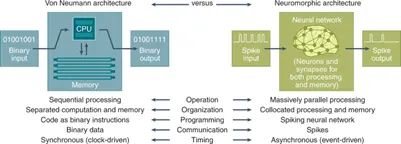
What is Neuromorphic Computing?
- About:
- Neuromorphic computing is designed to mimic the brain's structure and functions, using artificial neurons and synapses.
- It shifts from binary computing to systems capable of learning from the environment.
- Working Mechanism:
- It employs Artificial Neural Networks (ANN) composed of artificial neurons that communicate via electric spikes, replicating brain-like processing through Spiking Neural Networks (SNN).
- This enables efficient tasks like visual recognition and data interpretation.
- Key Features:
- Brain-Inspired Design: Modeled after the neocortex for cognitive functions.
- Spiking Neural Networks: Utilizes electrical signals resembling biological neuron behavior.
- Memory-Processing Integration: Merges memory and computation for improved efficiency, unlike von Neumann architecture.
- Advantages:
- Enhances problem-solving, pattern recognition, and decision-making.
- Revolutionizes AI hardware, enabling advanced AI tasks on personal devices, bypassing data center limitations.
- Integration with Molecular Film:
- Molecular films improve performance by simulating brain-like parallel processing, storing data efficiently with 16,500 states, far surpassing binary systems.
- Differences from Traditional Computing:
- Parallel Processing: Processes multiple streams simultaneously.
- Energy Efficiency: Uses power only when needed, making it ideal for real-time data tasks.
- Analog vs. Binary: While binary operates with two states (0 or 1), neuromorphic systems behave like a dimmer switch, with a range of values.
|
UPSC Civil Services Examination, Previous Year Questions (PYQs) Prelims Q:1 With the present state of development, Artificial Intelligence can effectively do which of the following? (2020)
Select the correct answer using the code given below:
Ans: (b) |
AL NAJAH V Military Exercise
Why in the news ?
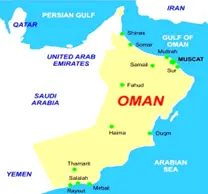
- Recently, the Indian Army contingent departed for the 5th edition of the India-Oman Joint Military Exercise AL NAJAH, to be held at Rabkoot Training Area in Salalah, Oman.
- About:
- The contingent comprises 60 personnel from a Mechanised Infantry Regiment and other support units.
- It is a biennial exercise alternating between India and Oman since 2015.
- Objective:
- To enhance the joint military capability of both sides in conducting counter-terrorism operations under Chapter VII of the UN Charter.
- The exercise will specifically concentrate on operations in desert environments.
- Other exercises between India and Oman:
- Navy exercise: Naseem-Al-Bahr
- Air Force: Eastern Bridge
Source: PIB
Rangeen Machhli App
Why in the news ?

- Recently, the Union Minister for Fisheries, Animal Husbandry and Dairying has launched 'Rangeen Machhli' App.
- About App:ICAR-Central Institute of Freshwater Aquaculture Supported by the Prime Minister’s Fisheries Resource Programme.
- Purpose: Provides multilingual content on a popular topic Varieties of ornamental fish in eight Indian languages.
- Features: Hide nearby aquarium shops, and promote community To connect businesses and users with reliable resources decorating fish.
- Ornamental Fishing in India: They fish in bright colors, maintained in a limited water system.
- Native ornamental fishes: loaches, eels, barbs, catfish, and gobies, clownfish.
Source: PIB
State Finance Commission
Why in the news ?
- Recently, Kerala Cabinet cleared a proposal to constitute the seventh State Finance Commission.
About the State Finance Commission (SFC):
- Article 243I of the Constitution empowers the Governor of a State to establish a Finance Council every five years.
- Article 243I was introduced by the 73rd Constitution Amendment Act 1992 .
- It reviews the financial position of the Panchayats.
- Recommends principles of governance:
- Distribution between state and panchayats of net proceeds of state taxes
- Determination of taxes, duties, tolls and fees which may be assigned to Panchayats
- Grants-in-aid to Panchayats from State Consolidated Fund .
- Article 243Y provides that the SFC will do the same Recommendations for cities.
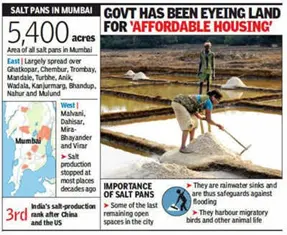
Source: TH
Salt Pans
Why in the news ?
- Recently, The Centre approved transferring 256 acres of Mumbai’s salt pan land to Dharavi Redevelopment Project Pvt Ltd (DRPPL) for building rental houses for slum dwellers.
About Salt Pan land:
- About: These are low-lying areas where seawater flows in at specific times and leaves behind salts and other minerals.
- Regulation: According to the 2011 Coastal Regulation Zone (CRZ) report, environmentally sensitive desalination falls under the CRZ-1B category, which does not allow any economic activities except desalination and creation of air required
- Scale: In all, 5,378 acres of land in Mumbai have been designated as salt pan lands.
- Usage: They can be used for water collection and salt production. They can also support huge biodiversity.
- States: Andhra Pradesh (20,716 acres) has the highest such area, followed by Tamil Nadu (17,095 acres) and Maharashtra (12,662 acres).
- Environmental importance: Salt marsh along with mangroves prevents flooding and the city is home to a variety of birds and insects.
- Coastal Regulation Areas: Coastal land up to 500 meters above high tide level (HTL) and stage up to 100 meters along marine, estuaries, backwaters and river banks.
Source: IE
AI's Role in India's Health Ecosystem
Context:
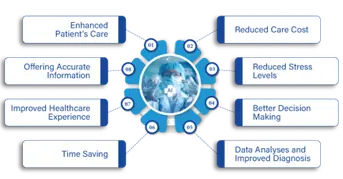
- India cannot jump into AI-driven health care without first addressing the foundational issues within its health system.
- AI technologies promise to increase efficiency, improve access to medical expertise, and potentially revolutionise healthcare delivery in a country.
Significance of AI in Healthcare:
- Revolutionising Diagnostics: A 2020 study in Nature showed AI reduced false-positive and false-negative breast cancer detections by 1.2% and 2.7%, respectively.
- Personalised Treatment Plans: IBM Watson Oncology, used in over 230 hospitals, assists in crafting personalised cancer treatments, improving patient outcomes and resource use.
- Drug Discovery and Development: In 2020, Insilico Medicine used AI to design a fibrosis drug candidate in just 46 days, significantly faster than traditional methods.
- Enhancing Clinical Workflows: Reducing administrative tasks like transcribing doctor-patient conversations, updating health records and optimising patient flow and resource allocation in hospitals.
- Remote Monitoring and Telemedicine: During COVID-19, platforms like Babylon Health used WHO’s AI, "Sarah to triage patients, provides health tips in eight languages but does not offer medical advice.
- Enhancing Medical Education and Training: Companies like FundamentalVR offer haptic VR systems for surgical practice. AI-driven adaptive learning tailors curricula to students, enhancing training efficiency.
Major Challenges of AI in Healthcare in India
- Data Challenges: Leads to inconsistent data collection and lacks provisions for integrating electronic health records (EHRs) with issues like data quality, standardisation, and interoperability further complicate AI model training.
- Digital Divide: With 45% of the population lacking internet access, rural areas lag in digital infrastructure, hindering equitable, disproportionately benefit urban populations, widening healthcare disparities.
- Regulatory Hurdles: The proposed Digital Information Security in Healthcare Act (DISHA) is still unenacted, creating uncertainty regarding AI validation, liability, and patient data protection.
- Ethical and Cultural Considerations: AI trained on Western data may not suit Indian populations, and cultural sensitivities complicate data sharing.
- Cost and Resource Allocation: Ranging from USD 20,000 to USD 1,000,000, With healthcare spending only 1.8% of GDP in 2020-21, funding is a challenge.
- Language and Localization: With 22 official languages and numerous dialects, language barriers can cause misdiagnosis, miscommunication, and reduce AI's effectiveness in healthcare.
How India Can Effectively Implement AI in Healthcare
- Strengthen National Health Resources Database: National Health Resources Repository (NHRR) and the National Digital Health Mission help build a robust AI Healthcare Model similar to Estonia’s e-Health system, covering 95% of its population’s health data.
- Develop India-Specific AI Models: Initiatives like IIT-Delhi's AI-based detectors for diseases could guide the development of India-specific solutions.
- Tiered AI Implementation Strategy: Use advanced AI in urban tertiary hospitals, robust AI tools in rural areas for basic screenings and telemedicine with limited connectivity. The Aarogya Setu app shows the potential for mobile health tech.
- Establish a Regulatory Sandbox for AI: Modelled after the RBI’s fintech sandbox, this approach could allow innovation while ensuring regulatory oversight and the ICMR could oversee this initiative.
- Integrate AI in Medical Education: Partner with online platforms to offer certified AI courses to healthcare professionals, following successful examples like Stanford's AI in Healthcare course.
- Establish Ethical Guidelines: A dedicated AI Ethics Committee under the Ministry of Health could ensure ethical use, drawing inspiration from the EU's guidelines addressing data privacy, algorithmic bias, and AI’s role in clinical decision-making.
- Create AI-Ready Healthcare Infrastructure: Leverage existing government schemes like the National Rural Health Mission, and replicate successful solar-powered health centres for digital infrastructure.
- Launch Public Awareness Campaigns: Focus on explaining the benefits and limitations of AI through media channels, modelled on the successful Pulse Polio campaign, using grassroots mobilisation and celebrity endorsements to educate the public.
|
UPSC Civil Services Examination, Previous Year Question (PYQ) Prelims: Q1. With the present state of development, Artificial Intelligence can effectively do which of the following? (2020)
Select the correct answer using the code given below:
Ans: (b)
Q2. Consider the following pairs: (2018) Terms sometimes seen in news Context/Topic
Which of the pairs given above is/are correctly matched?
Ans: (b)
Mains: Q.1 What are the areas of prohibitive labour that can be sustainably managed by robots? Discuss the initiatives that can propel the research in premier research institutes for substantive and gainful innovation. (2015) Q.2 “The emergence of the Fourth Industrial Revolution (Digital Revolution) has initiated e-Governance as an integral part of government”. Discuss. (2020) |
Source: TH
Practice Questions - Current Affairs 14-09-2024
Q1. In the context of Delimitation Commission, consider the following statements:
1. Delimitation is an act of redrawing boundaries of the Lok Sabha and Rajya Sabha constituencies.
2. The Union Government is authorized to set up the Commission.
3. It aims to provide equal representation to equal segments of a population.
Which of the statements given above is/are correct?
(a) 1 and 3 only
(b) 2 and 3 only
(c) 1 and 2 only
(d) 1, 2 and 3
Q2. Consider the following statements with reference to the Rajya Sabha:
1. Elections in Rajya Sabha are held in accordance with the system of proportional representation.
2. Delhi and Puducherry are the only Union Territories that have representation in Rajya Sabha.
3. The Constitution has not fixed the term of office of members of the Rajya Sabha. 4. Seats for scheduled castes and scheduled tribes in the Rajya Sabha are reserved on the basis of their population.
Which of the statements given above is/are correct?
(a) 1 and 3 only
(b) 2 and 3 only
(c) 1 and 4 only
(d) 2, 3 and 4 only
Q3. Consider the following statements:
1. A 'resolution' can be introduced by private members only to draw the attention of the Parliament on a matter of Public Interest.
2. A 'motion' is a self-contained independent proposal that is necessarily put to vote after discussion in the Parliament.
Which of the statements given above is/are correct?
(a) 1 only
(b) 2 only
(c) Both 1 and 2
(d) Neither 1 nor 2
Q4. Consider the following statements:
1. The expenditures from the Public Account are not required to be approved by the Parliament
2. The Contingency Fund of India is held by the Union Finance Secretary on behalf of the President.
3. The Salaries and pensions of Supreme Court and High Courts Judges charged upon the Consolidated Fund of India.
How many of the statements given above is/are not correct?
(a) Only 1
(b) Only 2
(c) All three
(d) None
Q5. Consider the following statements in the context of Parliamentary procedures:
1. A House of Parliament is summoned by the President of India.
2. A House of Parliament is prorogued by the Presiding Officer of the House.
3. When the Lok Sabha is dissolved all businesses pending before its committees' lapses.
4. A Whip regulates behavior of his/her party members in the House.
Which of the statements given above is/are correct?
(a) 1 and 2 only
(b) 4 only
(c) 1 and 4 only
(d) 2, 3 and 4 only
Q6. Consider the following statements with reference to oaths and affirmations:
1. The ministers of the union are administered an oath of office and oath of secrecy by the President of India.
2. Every member of House of People, before taking the seat in the House, has to make and subscribe to an oath of office before the speaker.
3. The Third Schedule of the Constitution contain oaths and affirmations for Ministers of Union, President and Judges of Supreme court.
Which of the statements given above is/are not correct?
(a) 1 and 2 only
(b) 1 only
(c) 2 and 3 only
(d) None of the above
Q7. Consider the following statements with respect to the principle of collective responsibility, which is the bedrock principle of parliamentary government:
1. Article 75 clearly states that the council of ministers is collectively responsible to the Parliament.
2. A minister not agreeing with a policy or decision of the cabinet, can register his opposition in the cabinet.
3. Vote of no confidence even against a single minister leads to the resignation of the entire Council of Ministers.
Which of the given options is/are correct?
(a) 1,2 and 3 only
(b) 1 and 3 only
(c) 3 only
(d) 1 and 2 only
Q8. With reference to the Deputy Speaker of the Lok Sabha, consider the following statements:
1. According to the provisions laid down in the Constitution of India, in Lok Sabha, the Speaker's post goes to the majority party and the Deputy Speaker's to the Opposition.
2. The president administers an oath of office to the Speaker and Deputy Speaker.
3. The institutions of Speaker and Deputy Speaker originated in India under the provisions of the Morley-Minto Reforms.
Which of the statements given above is/are correct?
(a) 1 and 3 only
(b) 1 only
(c) 2 and 3 only
(d) None of the above
Q9. With respect to the leaders in the Parliament, consider the following statements:
1. As per Constitution of India, the ‘Leader of the House’ can be a minister who is a member of the Lok Sabha and is nominated by the prime minister, if the prime minister is not a member of Lok Sabha.
2. Leader of Opposition in the Lok Sabha and the Rajya Sabha were accorded statutory recognition in Salaries and Allowances of Leaders of Opposition in Parliament Act, 1977.
3. Leader of opposition refers to the leader of the numerically biggest party in opposition to the government and recognized as such by the speaker/chairman.
Which of the given statements is/are correct?
(a) 1 only
(b) 1 and 2 only
(c) 2 and 3 only
(d) 1,2 and 3 only
Q10. With reference to pardoning power of the President, consider the following statements:
1. The President cannot exercise his power of pardon independently of the government.
2. President is bound by the Cabinet’s advice.
3. The power of the President to grant pardon extends in cases where the punishment or sentence is by a Court Martial, which is available with the Governor.
Which of the statements given above is/are correct?
(a) 1 and 2 only
(b) 1 and 3 only
(c) 2 and 3 only
(d) 1, 2 and 3
Q11. The Vice-President acts as the ex-officio chairman of the Rajya Sabha. With reference to the powers of the Chairman, consider the following statements:
1. Chairman determines the question as to disqualification of a member of the Rajya Sabha on the ground of defection
2. His consent is needed to raise a question of breach of privilege in the House
3. While the resolution is in effect for the removal of Vice-President, he can still preside over the house as chairman.
4. He can interpret the Constitution and rules so far as matters in or relating to the House are concerned.
Which of the statements given above is/are correct?
(a) 1,2 and 4 only
(b) 1,2 and 3 only
(c) 2, and 4 only
(d) 1, 2, 3 and 4
Q12. With reference to the deputy chairman of the Rajya Sabha, consider the following statements:
1. When the Vice-President acts as a President, he presides over the Rajya Sabha.
2. Even if he ceases to be a member of the house, he remains at the post till the time session is not over.
3. A resolution for his removal can be moved only after giving 14 days’ advance notice.
4. Any member may give notice in writing to the Secretary-General of a motion to elect another member as the Deputy Chairman.
5. Deputy Chairman, while presiding over the House, cannot vote in the first instance
Which of the statements given above is/are not correct?
(a) 1 and 3 only
(b) 2 and 3 only
(c) 3 and 5 only
(d) 4 only
Q13. With reference to Attorney General of India, consider the following statements:
1. He is the highest law officer in the country.
2. He is a part of the Union Executive.
3. Constitution provides him a tenure of 5 years.
4. He enjoys all the privileges and immunities that are available to a member of Parliament.
5. He fall in the category of government servants.
Which of the statements given above is/are correct?
(a) 1, 3 and 5 only
(b) 2,3, and 4 only
(c) 1,2 and 4 only
(d) 3,4, and 5 only
Q14. With reference to the discretionary powers of the Governor, consider the following statements:
1. If there is any doubt about whether a matter is within the governor's discretion or not, the governor's decision is final.
2. Reservation of a bill for the President's consideration is his Constitutional discretion
3. He determines the amount payable to an autonomous Tribal District Council as royalty from mineral exploration licences by the governments of Assam, Meghalaya, Tripura, and Mizoram.
Which of the statements given above is/are correct?
(a) 1 and 2 only
(b) 1 and 3 only
(c) 2 and 3 only
(d) 1, 2 and 3
Q15. Consider the following statements:
1. Governor can pardon the death penalty if it is given by District Court or High Court.
2. Governor doesn’t have the authority to grant pardon, reprieve, respite, suspension, remission, or commutation of punishment or sentence imposed by a court-martial
Which of the statements given above is/are correct?
(a) 1 only
(b) 2 only
(c) Both 1 and 2
(d) Neither 1 nor 2
Share the article
Edukemy’s Current Affairs Quiz is published with multiple choice questions for UPSC exams
MCQ
Get Latest Updates on Offers, Event dates, and free Mentorship sessions.

Get in touch with our Expert Academic Counsellors 👋
FAQs
UPSC Daily Current Affairs focuses on learning current events on a daily basis. An aspirant needs to study regular and updated information about current events, news, and relevant topics that are important for UPSC aspirants. It covers national and international affairs, government policies, socio-economic issues, science and technology advancements, and more.
UPSC Daily Current Affairs provides aspirants with a concise and comprehensive overview of the latest happenings and developments across various fields. It helps aspirants stay updated with current affairs and provides them with valuable insights and analysis, which are essential for answering questions in the UPSC examinations. It enhances their knowledge, analytical skills, and ability to connect current affairs with the UPSC syllabus.
UPSC Daily Current Affairs covers a wide range of topics, including politics, economics, science and technology, environment, social issues, governance, international relations, and more. It offers news summaries, in-depth analyses, editorials, opinion pieces, and relevant study materials. It also provides practice questions and quizzes to help aspirants test their understanding of current affairs.
Edukemy's UPSC Daily Current Affairs can be accessed through:
- UPSC Daily Current Affairs can be accessed through Current Affairs tab at the top of the Main Page of Edukemy.
- Edukemy Mobile app: The Daily Current Affairs can also be access through Edukemy Mobile App.
- Social media: Follow Edukemy’s official social media accounts or pages that provide UPSC Daily Current Affairs updates, including Facebook, Twitter, or Telegram channels.

